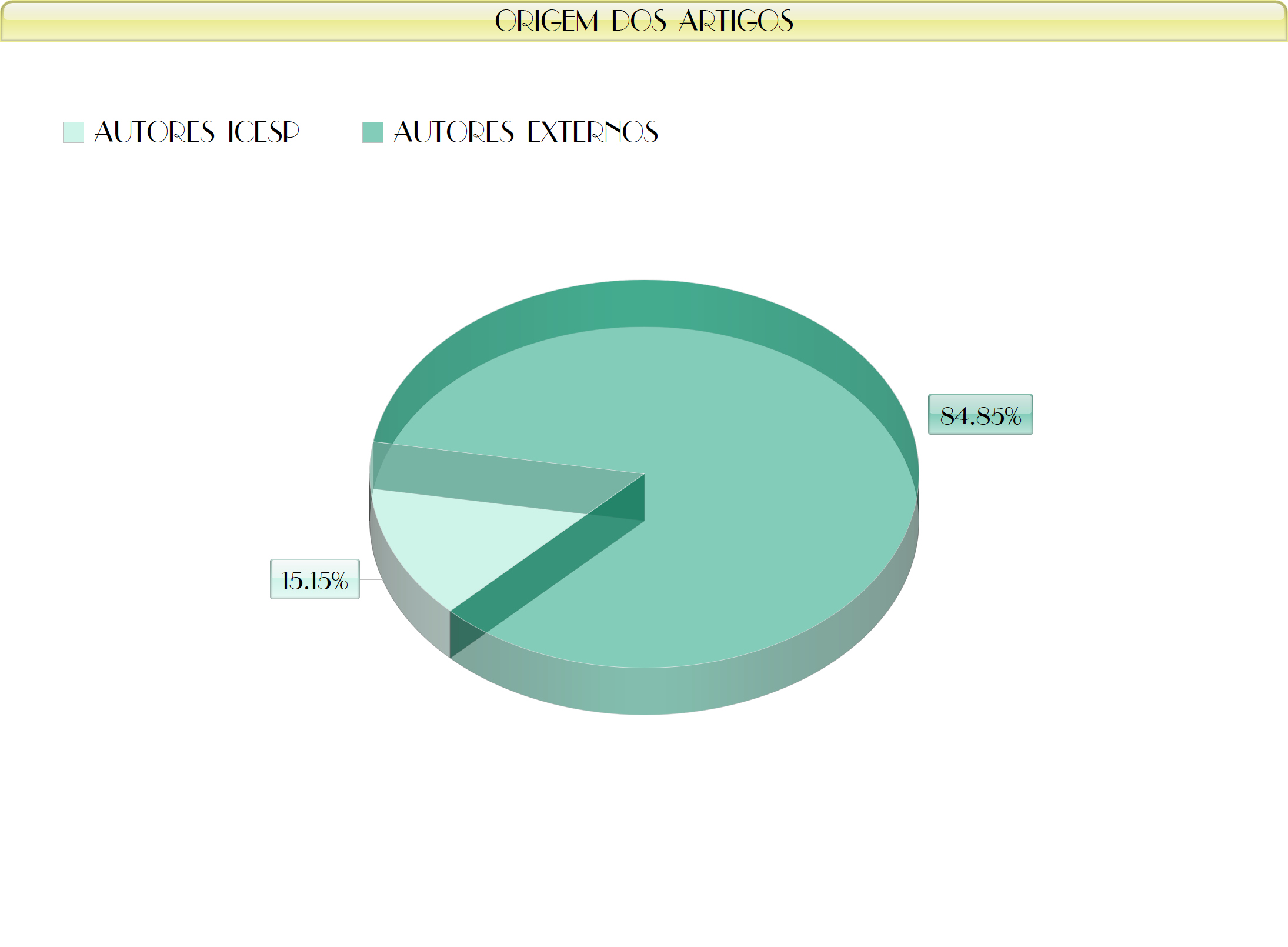BACULOVÍRUS: UM VÍRUS VERSÁTIL USADO NO CONTROLE BIOLÓGICO E COMO VETOR DE EXPRESSÃO DE PROTEÍNAS HETERÓLOGAS APLICADAS NA SAÚDE HUMANA
Resumo
RESUMO
Objetivo: revisar a história, morfologia, o ciclo de vida de infecção do baculovírus no inseto hospedeiro e finalmente as aplicações de expressão mediada por baculovírus no controle de pragas e terapia genética em células de mamíferos. Fonte de dados: o desenvolvimento desse trabalho consistiu em uma revisão de literatura. As bases de dados utilizadas foram: SciELO e PubMed, onde foram feitas buscas por artigos e livros referentes ao baculovírus com enfoque na sua morfologia, ciclo de replicação e aplicações biotecnológicas na área de saúde. Adotou-se como critério inicial para seleção a utilização das palavras-chaves “baculovirus”, “baculovirus life cycle”, “gene therapy”, “baculovirus applications” e “aplicações biotecnológicas”. Resultados: nas últimas décadas, com o avanço da biologia molecular, os baculovírus evoluíram de um simples vírus de insetos, usados até então apenas no controle biológico de pragas agrícolas, para ferramentas biotecnológicas versáteis, que podem ser usadas para infectar células de insetos e também transduzir células de mamíferos para a expressão de uma grande variedade de proteínas heterólogas. Conclusão: o baculovírus surgiu como um novo vetor para a entrega de genes. Além disso, o uso da transferência de genes mediada por baculovírus foi consideravelmente expandida para triagem de medicamentos, exibição de genes eucarióticos, terapia de câncer, engenharia de tecidos, vacinas e outras aplicações.
ABSTRACT
Objective: to review the history, morphology, life cycle of baculovirus infection in the host insect, and finally as applications of baculovirus-mediated expression in pest control and gene therapy in mammalian cells. Data source: the databases used were: SciELO and PubMed, where were searched for articles and books related to baculovirus focusing on its morphology, replication cycle, and biotechnological applications in health subjects. It was adopted as initial criteria for selecting the keywords: “baculovirus”, “baculovirus life cycle”, “gene therapy”, “baculovirus applications” and “biotechnological applications”. Results: in recent decades, with the advancement of molecular biology, baculovirus has evolved from a simple insect virus used only in biological control of agricultural pests, to versatile biotechnological tools that can be used to infect insect cells and also transducing mammalian cells for the expression of a wide variety of heterologous proteins. Conclusion: therefore, baculovirus has emerged as a new vector for gene delivery. Also, the use of baculovirus-mediated gene transfer has been considerably expanded for drug screening, eukaryotic gene display, cancer therapy, tissue engineering, vaccines, and other applications.
Figshare DOI: 10.6084/m9.figshare.12838052
Palavras-chave
Referências
Abe T, Takahashi H, Hamazaki H, Miyano-Kurosaki N, Matsuura Y and Takaku H. Baculovirus induces an innate immune response and confers protection from lethal influenza virus infection in mice. J. Immunol. 2003; 171:1133-1139.
Airenne KJ, Hiltunen MO, Turunen MP, Turunen AM, Laitinen OH, Kulo‐maa MS and Yla-herttuala S. Baculovirus-mediated periadventitial gene transfer to rabbit carotid artery. Gene Ther. 2000; 7:1499-1504
Amanna IJ and Slifka MK. Wanted, dead or alive: new viral vaccines. Antiviral Res. 2009; 84:119-130.
Anguela XM and High KA. Entering the Modern Era of Gene Therapy. Annu. Rev. Med. 2019; 70:273–88.
Aoki H; Sakoda Y, Jukuroki K, Takada A, Kida H and Fukusho A. Induction of antibodies in mice by a recombinant baculovirus expressing pseudorabies virus glycoprotein B in mammalian cells. Vet Microbiol. 1999; 68:197-207.
Baxter D. Active and passive immunity, vaccine types, excipients and licensing. Occup Med (Lond). 2007; 57:552-556.
Bergold GH. Die isolierung des polyeder-virus and die natur der polyeder. Z Naturforsch. 1947; 1947:122–143.
Bird JT and Elgee DE. A virus disease and introduced parasites as factors controlling the European spruce sawfly, Diprion hercyniae Htd. in central New Brunswick. Can. Entomol. 1957; 89:371–378.
Blissard GW and Rohrmann GF. Baculovirus diversity and molecular biology. Annu. Rev. Entomol. 1990 ;35:127-155.
Carrijo-Carvalho LC and Chudzinski-Tavassi AM. The venom of the Lonomia caterpillar: An overview. Toxicon. 2007; 49(6):741-757.
Devarajan P. Update on mechanisms of ischemic acute kidney injury. J. Am. Soc. Nephrol. 2006; 17:1503-1520.
Diaz JH. The evolving global epidemiology, syndromic classification, management, and prevention of caterpillar envenoming. Am. J. Trop. Med. Hyg. 2005; 72:347–357.
Dijkman GA and Debruyne FMJ. Epidemiology of prostate cancer. Eur Urol. 1996; 30(3):281–295.
Draper SJ, Moore AC, Goodman AL, et al. Effective induction of high-titer antibodies by viral vector vaccines. Nat. Med. 2008; 14:819-821.
Ffrench-Constant RH. The molecular genetics of insecticide resistance. Genetics. 2013; 194(4):807–15.
Fuller E, Elderd BD and Dwyer G. Pathogen persistence in the environment and insect-baculovirus interactions: Disease-Density thresholds, epidemic burnout, and insect outbreaks. Am. Nat. 2012; 179:E70–E96.
Fuxa JR. Ecology of insect nucleopolyhedroviruses. Agric. Ecosyst. Environ. 2004; 103:27–43.
Gamborgi GP, Metcalf EB and Barros EJG. Acute renal failure provoked by toxin from caterpillars of the species Lonomia obliqua. Toxicon. 2006; 47:68–74.
Geisler C, Mabashi-Asazuma H and Jarvis DL. An Overview and History of Glyco-Engineering in Insect Expression Systems. In: Alexandra Castilho (Ed.), Glyco-Engineering: Methods and Protocols, Methods in Molecular Biology. New York: Springer Science Business Media; 2015. 1321:131-152.
Glorioso JC, Mata M and Fink DJ. Exploiting the neurotherapeutic potential of peptides: targeted delivery using HSV vectors. Expert Opin. Biol. Ther. 2003a; 3:1233-1239.
Glorioso JC, Mata M and Fink DJ. Gene therapy for chronic pain. Curr.Opin. Mol. Ther. 2003b; 5:483-488.
Groves MJ, Schänzer A, Simpson AJ, An SF, Kuo LT and Scaravilli F. Profile of adult rat sensory neuron loss, apoptosis and replacement after sciatic nerve crush. J. Neurocytol. 2003; 32: 113-122.
Grula, MA, Buller PL, and Weaver RF. α-Amanitin-Resistant Viral RNA Synthesis in Nuclei Isolated from Nuclear Polyhedrosis Virus-Infected Heliothis zea Larvae and Spodoptera frugiperda Cells. J Virol. 1981; 38(3):916–921.
Haase S, Sciocco-Cap A and Romanowski V. Baculovirus Insecticides in Latin America: Historical Overview, Current Status and Future Perspectives. Viruses. 2015; 7:2230-2267.
Herniou EA and Jehle JA. Baculovirus phylogeny and evolution. Curr. Drug Targets. 2007; 8:1043–1050.
Herniou EA, Arif BM, Becnel JJ, Bilssard GW, Bonning B, Harrison R et al. Family Baculoviridae. In: King AMQ, Adams MJ, Carstens EB, Lefkowitz EJ (eds). Virus Taxonomy, Classification and Nomenclature of Viruses. Ninth Report of the International Committee on Taxonomy of Viruses. 2012. 163–173. Elsevier Academic Press, Amsterdam.
Hitchman RB, Locanto E, Possee RD and King LA. Optimizing the baculovirus expression vector system. Methods. 2011; 55:52–7.
Holland EC. Glioblastoma multiforme: the terminator. Proc Natl Acad Sci U S A. 2000; 97:6242–6244.
Horton HM and Burand J.P. Saturable attachment sites for polyhedron-derived baculovirus on insect cells and evidence for entry via direct membrane fusion. J Virol. 1993; 67:1860–1868
Hu YC. Baculoviral vectors for gene delivery: a review. Curr. Gene Ther. 2008; 8:54–65.
Ikeda M, Hamajima R and Kobayashi M. Baculoviruses: diversity, evolution and manipulation of insects. Entomological Science. 2015; 18:1–20.
Inceoglu AB, Kamita SG, Hinton AC, Huang Q, Severson TF, Kang K-d and Hammock BD. Genetically modified baculoviruses: a historical overview and future outlook. Adv. Virus Res. 2006; 68:323–360.
Iyori M, Yamamoto DS, Sakaguchi M, Mizutani M, Ogata S, Nishiura H, et al. DAF-shielded baculovirus-vectored vaccine enhances protection against malaria sporozoite challenge in mice. Malar. J. 2017; 16:390.
Jackson CA, Messinger J, Palmer MT, Peduzzi JD and Morrow CD. Gene expression in the muscle and central nervous system following intramuscular inoculation of encapsidated or naked poliovirus replicons. Virology. 2003; 314: 45-61.
Jehle JA, Blissard GW, Bonning BC, Cory JS, Herniou EA, Rohrmann GF, Theilmann DA, Thiem SM and Vlak JM. On the classification and nomenclature of baculoviruses: a proposal for revision. Arch. Virol. 2006; 151:1257–1266.
Kaba SA, Salcedo AM, Wafula PO, Vlak JM and van Oers MM. Development of a chitinase and v-cathepsin negative bacmid for improved integrity of secreted recombinant proteins. J. Virol. Methods. 2004; 122:113-118.
Katou Y, Ikeda M and Kobayashi M. Abortive replication of Bombyx mori nucleopolyhedrovirus in Sf9 and High Five cells: defective nuclear transport of the virions. Virology. 2006; 347:455–465.
Keddie BA, Aponte GW and Volkman LE. The pathway of infection of Autographa californica nuclear polyhedrosis virus in an insect host. Science. 1989; 243:1728–1730.
Kikhno I, Gutiérrez S, Croizier L, Croizier G and Ferber ML. Characterization of pif, a gene required for the per os infectivity of Spodoptera littoralis nucleopolyhedrovirus. J. Gen.l Virol. 2002; 83:3013–3022.
Komor AC, Kim YB, Packer MS, Zuris JA and Liu DR. Programmable editing of a target base in genomic DNA without double-stranded DNA cleavage. Nature. 2016; 533:420–424.
Kost TA, Condreay JP and Jarvis DL. Baculovirus as versatile vectors for protein expression in insect and mammalian cells. Nat. Biotechnol. 2005; 23:567–575.
Kumbhani DJ, Healey NA, Thatte HS, et al. Patients with diabetes mellitus undergoing cardiac surgery are at greater risk for developing intraoperative myocardial acidosis. J. Thorac. Cardiovasc. Surg. 2007; 133:1566-1572.
Kwang TW, Zeng X and Wang S. Manufacturing of AcMNPV baculovirus vectors to enable gene therapy trials. Molecular Therapy. Methods & Clinical Development. 2016; 3:15050.
Lapied B, Pennetier C, Apaire-Marchais V, Licznar P and Corbel V. Innovative applications for insect viruses: towards insecticide sensitization. Trends in Biotechnology. 2008; 27(4): 190-198.
Lehtolainen P, Tyynela K, Kannasto J, Airenne KJ and Yla-herttuala S. Baculoviruses exhibit restricted cell type specificity in rat brain: a comparison of baculovirus and adenovirus-mediated intracerebral gene transfer in vivo. Gene Ther. 2002; 9:1693-1699.
Li Y, Wang X, Guo H and Wang S. Axonal transport of recombinant baculovirus vectors. Mol. Ther. 2004; 10:1121–1129.
Long G, Pan X, Kormelink R, Vlak JM. Functional entry of baculovirus into insect and mammalian cells is dependent on clathrin-mediated endocytosis. J. Virol. 2006; 80:8830–8833.
Lopez-Neblina F, Toledo AH and Toledo-Pereyra LH. Molecular biology of apoptosis in ischemia and reperfusion. J. Invest. Surg. 2005; 18, 335-350.
Madhan S, Prabakaran M and Kwang J. Baculovirus as Vaccine Vectors. Curr. Gen. Ther. 2010. 10: 201-213.
Martignoni ME and Iwai PJ. A Catalog of Viral Diseases of Insects, Mites, and Ticks. Portland, Ore, U.S. Department of Agriculture, Forest Service, Pacific Northwest Research Station. General Technical Report PNW; 1986.No.:195.
McWilliam A. Environmental Impact of Baculoviruses. FAO. R7299_FTR_anx3. 2007. Available online: http://www.fao.org/docs/eims/upload/agrotech/2003/ R7299_FTR_anx3.pdf. Acessado em: 22 de outubro de 2019.
Monteiro F, Carinhas N, Carrondo MJT, Bernal V and Alves PM. Toward system420 level understanding of baculovirus-host cell interactions: from molecular fundamental 421 studies to large-scale proteomics approaches. Front. Microbiol. 2012; 3:391.
Moraes RHP. Identificação dos Inimigos Naturais de Lonomia obliqua Walker, 1855 (Lepidóptera: Saturniidae) e possíveis fatos determinantes do aumento de sua população [Dissertação de Mestrado]. Piracicaba:Escola Superior de Agricultura Luiz de Queiroz – ESALQ ; 2002.
Moscardi F, Souza ML, Castro MEB, Moscardi ML and Szewczyk B. Baculovirus Pesticides: Present State and Future Perspectives. In: Ahmad I, Ahmad F, Pichtel J, (Eds). Microbes and Microbial Technology: Agricultural and Environmental Applications (1st edition). New York: Springer; 2011. p415-445.
Ohkawa T, Volkman LE and Welch MD. Actin-based motility drives baculovirus transit to the nucleus and cell surface. J. Cell Biol. 2010; 190 (2):187–195.
Paillot A. Sur une nouvelle maladie du noyau au grasserie des chenilles de P. brassicae et un nouveau groupe de microoganismes parasites. Compt Rend. 1926; 182:180–182.
Passarelli AL and Guarino LA. Baculovirus late and very late gene regulation. Curr.DrugTargets. 2007; 8:1103–1115.
Passarelli AL and Miller LK. Identification and characterization of lef-1, a baculovirus gene involved in late and very late gene expression. J. Virol. 1993; 67:3481-3488.
Passarelli AL. Barriers to success: How baculoviruses establish efficient systemic infections. Virol. 2012; 411:383–392.
Premanand B, Wee PZ and Prabakaran M. Baculovirus Surface Display of Immunogenic Proteins for Vaccine Development . Viruses. 2018;10:298.
Ranson H, Burhani J, Lumjuan N, Black IV WC. Insecticide resistance in dengue vectors. TropIKAnet. 2010; 1:1-12.
Ritter T and Kupiec-Weglinski JW. Gene therapy for the prevention of ischemia/reperfusion injury in organ transplantation. Curr. Gene Ther. 2005; 5:101–109.
Rivero A, Vezilier J, Weill M, Read AF and Gandon S. Insecticide control of vector-borne diseases: when is insecticide resistance a problem? PLoS pathogens. 2010; 6(8):e1001000.
Rohrmann GF. Baculovirus Molecular Biology. 4th edition. Bethesda (MD). National Center for Biotechnology Information (US). 2019.
Saxena H. Microbial Managment of Crop-Pest. J. Biopestic. 2008; 1:32–37.
Stanbridge LJ, Dussupt V and Maitland NJ. Baculoviruses as vectors for gene therapy against human prostate cancer. J. Biomed. Biotechnol. 2003; 2:79-91.
Steele KH, Stone BJ, Franklin KM, Fath-Goodin A, Zhang X, Jiang H, Webb BA and Geisler C. Improving the Baculovirus Expression Vector System with Vankyrin-enhanced Technology. Biotechnol. Prog. 2017; 33:1496-1507.
Sternberg ED and Thomas MB. Insights from agriculture for the management of insecticide resistance in disease vectors. Evol. Appl. 2018; 11:404–414.
Szewczyk B, Hoyos-Carvajal L, Paluszek M, Skrzecz I and Lobo de Souza M. Baculoviruses re-emerging biopesticides. Biotechnol. Adv. 2006; 24:143–160.
Theilmann DA, Blissard GW, Bonning B, Jehle JA, O’Reilly DR, Rohrmann GF, Thiem S, and Vlak and JM. Baculoviridae. In: Fauquet CX, Mayo MA, Maniloff J, Desselberger U and Ball LA (eds). Virus Taxonomy – Classification and Nomenclature of Viruses. 8th Report of the International Committee on Viruses. 2005.177–185. Elsevier, Amsterdam.
Thomas CJ, Brown HL, Hawes CR, Lee BY, Min M-K, King LA and Possee RD. Localization of a baculovirus-induced chitinase in the insect cell endoplasmic reticulum. J. Virol. 1998; 72: 10207-10212.
Thorne RG and Frey WH II. Delivery of neurotrophic factors to the central nervous system: pharmacokinetic considerations. Clin. Pharmacokinet. 2001; 40:907-946.
Tjia ST, zu Altenschildesche GM. and Doerfler, W. Autographa californica nuclear polyhedrosis virus (AcNPV) DNA does not persist in mass cultures of mam‐ malian cells. Virol. 1983; 125:107-117.
Vago C, Aizawa K, Ignoffo C, Martignoni ME, Tarasevitch L and Tinsley TW. Editorial: Present status of the nomenclature and classification of invertebrate viruses. J Invertebr Pathol. 1974; 23:133–134.
Valdivia A, Pérez-Alvarez S, Aroca-Aguila, JD, Ikuta I and Jordán J. Superoxide dismutases: a physiopharmacological update. J. Physiol. Biochem. 2009; 65:195-208.
van Oers MM and Vlak JM. Baculovirus genomics. Curr Drug Targets. 2007; 8(10):1051-1068.
Vasantharaj DB. Biotechnological approaches in IPM and their impact on environment. J. Biopestic. 2008; 1:1–5.
Volkman LE and Summers MD. Autographa californica nuclear polyhedrosis virus: Comparitive infectivity of the occluded, alkali-liberated, and nonoccluded forms. J Invertebr Pathol. 1977; 30:102–103.
Wang C-Y, Li F, Yang Y, Guo H-Y, Wu C-X and Wang S. Recombinant baculovirus containing the Diphtheria toxin A gene for malignant glioma therapy. Cancer Res. 2006; 66:5798-5806.
Wang P and Granados RR .An intestinal mucin is the target substrate for a baculovirus enhancing. Proc. Natl. Acad. Sci. USA. 1997; 94:6977–6982.
Wang X, Wang C, Zeng J, Xu X, Hwang PYK, Yee W-C, Ng YK and Wang S .Gene Transfer to Dorsal Root Ganglia by Intrathecal Injection: Effects on Regeneration of Peripheral Nerves. Mol. Ther. 2005; 12:314-320.
Whalon ME, Mota-Sanchez D and Hollingworth RM. Global Pesticide Resistance in Arthropods. CAB International: Wallingford, UK, 2008.
Wolff JL, Moraes RHP, Kitajima E, Leal EDS. and Zanotto PMA. Identification and characterization of a baculovirus from Lonomia obliqua (Lepidoptera: Saturniidae). J. Invertebr. Pathol. 2002; 79:137–145.
Xeros N. Cytoplasmic polyhedral virus diseases. Nature. 1952; 170 (4338):1073.
Yoshida S, Kondoh D, Arai E, et al. Baculovirus virions displaying Plasmodium berghei circumsporozoite protein protect mice against malaria sporozoite infection. Virol. 3003; 316:161-170.
Zhang F, Murhammer DW and Linhardt RJ. Enzyme kinetics and glycan structural characterization of secreted alkaline phosphatase prepared using the baculovirus expression vector system. Appl. Biochem. Biotechnol. 2002; 101:197-210.
Apontamentos
- Não há apontamentos.
Revista Brasileira de Pesquisa em Ciências da Saúde - RBPeCS - ISSN: 2446-5577
Indexadores:













